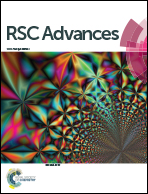Base induced synthesis of 4H-1,4-benzothiazines and their computational studies†
Abstract
A one pot synthesis of 1,4-benzothiazines from 1,3-benzothiazolium cations and α-haloketones through ring expansion under ultrasonication was carried out by employing optimal 5% sodium hydroxide and characterization was done with the help of various spectroscopic techniques viz. NMR, IR and mass spectrometry. Single crystal X-ray diffraction and computational studies of (4-bromophenyl)(4-methyl-4H-benzo[b][1,4]thiazin-2-yl)methanone (3c) were also performed. Different concentrations of different bases (NaOH, Na2CO3, NaHCO3 solutions etc.) were used to obtain 1,4-benzothiazine derivatives. But, the best results were obtained with 5% NaOH solution (3.7 equivalents) for the synthesis of single product 1,4-benzothiazine derivatives while, with other concentrations, the reaction did not proceed to a single product. Quantum chemical calculations were done to find the optimized geometry and to correlate the experimental and calculated values of the bond parametres and 13C NMR chemical shifts of the synthesized compound. The optimized geometry was obtained using density functional theory (DFT) with the basis set 6-31G(d). The theoretical values of the 1H NMR chemical shifts were in agreement with the experimental values. The photophysical properties of some of the synthesized compounds were studied with the help of ultraviolet-visible and fluorescence spectroscopy.


 Please wait while we load your content...
Please wait while we load your content...